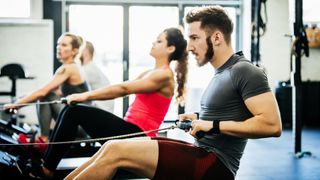Rowing machine muscles worked: fire up your quads, glutes, and more
Rowing machine muscles worked extend to both the upper and lower body, so you’re guaranteed an efficient workout

Rowing machine muscles worked include the quads, glutes, triceps, and more, making it a great whole-body workout. This heart-pumping, high-intensity exercise activates many of the muscles that are under-used when we sit for long periods. It’s also a relatively low-impact activity, so it puts minimal strain on your joints.
The secret to reaping the most benefits from this exercise machine is mastering the correct form. Practicing proper techniques can target the right muscles for each phase of the movement and reduce your risk of injury. Consistency is also important if you want to hit your goals – rowing machines can be one of the best exercise machines to lose weight, as long as you make sure you’re using them regularly.
If you’re looking to get one of these machines for your home, have a scroll through our round-up of the best rowing machines, where you’ll find a detailed comparison of this year’s top models. But if you’re looking for a breakdown of the muscles activated while you row – and some tips on how to correct your form – then read on.
- Read more: Rowing machine benefits
Rowing machine muscles used

If you’re using a rowing machine correctly, you’ll use muscles in your lower body, upper body and even your core. Matt Jones, Performance Coach at P3rform says: “Using a rowing machine has lots of benefits and it makes for a super versatile workout. It’s low impact, meaning it’s accessible to a wide range of people, from those just starting out on their journey to those getting back into fitness after a break.”
Understanding the muscles which are activated during a rowing stroke can be invaluable when it comes to honing your technique. When watching professional rowers, you’d be forgiven for thinking that it’s all one seamless movement. Yet there are four distinct phases: the catch, the drive, the finish, and the recovery. Each of these movements recruits different muscles and learning about them can help you use a rowing machine properly.
Jones gives this step-by-step advice: “The catch position is your starting position. Your triceps are engaged to extend your arms and your core is braced to keep you steady and upright.” Your glutes, hamstrings and triceps are activated here.
Next is the drive which is when you’ll want to generate explosive power and push back from your legs first and then move the handle back. Jones explains this movement “engages the biceps and back as well as the glutes and hamstrings.”
This is followed by the finish where Jones explains that: “you are fully extended, with the abdominals braced to keep you steady and glutes squeezed for power.”
He adds: “Finally, recovery is the eccentric phase (when your muscles lengthen) as you release back to the catch position, so the hamstrings contract and triceps extend.” Take advantage of this phase to take a deep breath and prepare mentally and physically for the next drive. Keep practicing until you can confidently build a rhythm.
Rowing form tips and muscle activation
For all its benefits, the rower can be intimidating until you have the hang of the technique. Form is essential both for maximizing your workout and reducing the risk of injury.
We asked Damien Joyner, owner of Incremental Fitness and health coach at WorkStrong for his top tips. “When leaning forward during the catch phase, focus on leaning from the hips instead of rounding the back. This tall posture is kept throughout the phases by engaging your core and back muscles and hinging at the hips.”
Joyner adds that a common mistake he sees is “pulling with the arms during the drive phase before the legs are fully extended. This isn't an efficient way to row and can tire out the arms quickly. Avoid the urge to pull during the catch and instead focus on driving the legs back fully before pulling the handlebar to the chest.”
Fatigue can contribute to poor form. Joyner’s recommendation is to “focus on a good and steady flow instead of rushing to go as quickly as possible. Often good form is destroyed when rushing and not using the body as a unit in the proper steps.”
Building muscle with rowing
Looking to build muscle and get a stronger core? The rowing machine can be part of your strategy. Joyner explains that: “As a rowing machine hits all the major muscles it can provide a full-body workout, as well as help improve muscular strength.”
If your primary goal is to build strength, you’ll still want to incorporate weight lifting into your routine. Joyner suggests doing “short bursts on the rower and moving with weights to hit the muscles from different angles.” He also recommends picking standing exercises such as lateral lunges, deadlifts and squats.
Cranking up the resistance can make rowing more challenging though Joyner cautions against increasing it to the level where it compromises your form. As always, you should focus on nailing your technique first before increasing resistance.
- Read more: Is the rowing machine a good workout?
Sign up for the Live Science daily newsletter now
Get the world’s most fascinating discoveries delivered straight to your inbox.
Louise Bond is a UK-based writer specializing in health and wellbeing. She has over eight years of experience in management within health and care and brings this passion and expertise to her writing. Louise has been published in The Guardian, Planet Mindful and Psychreg among others. She is at her happiest when she is out in nature, whether that’s on an invigorating hike or pottering in the garden.

